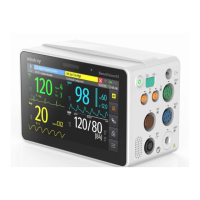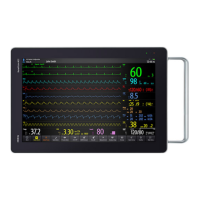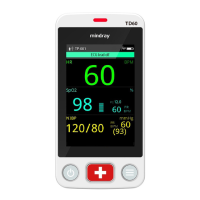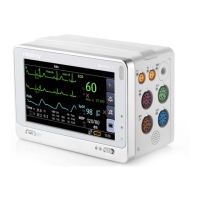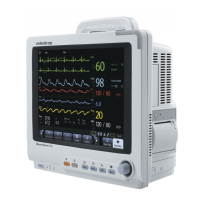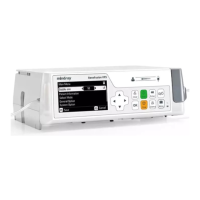10 - 12 BeneVision N Series Patient Monitor Operator’s Manual
• When the CPB mode is entered, the monitor stops all NIBP measurements. You can restart NIBP
measurements after entering the CPB mode.
10.12.2 Exiting the CPB Mode
To exit the CPB mode, choose either of the following ways:
■ Select the CPB Mode quick key.
■ Select the Main Menu quick key → from the Alarm column select Exit CPB Mode.
10.13 Intubation Mode
Intubation mode is available for Resp, CO
2
, AG and RM monitoring. When performing intubation during general
anesthesia, you can put the monitor in the intubation mode in order to inactivate unnecessary alarms.
In the intubation mode, Resp, CO
2
, RM, and AG related physiological alarms are switched off.
10.13.1 Entering the Intubation Mode
To enter the intubation mode, choose either of the following ways:
■ Select the Intubation Mode quick key.
■ From the bottom of the Resp, CO2, AG, or RM menu, select Intubation Mode.
■ Select the Main Menu quick key → from the Alarm column select Intubation Mode.
10.13.2 Exiting the Intubation Mode
To exit the intubation mode, choose either of the following ways:
■ Select the Exit Intubation Mode quick key.
■ From the bottom of the Resp, CO2, AG, or RM menu, select Exit Intubation Mode.
■ Select the Main Menu quick key → from the Alarm column→ select Exit Intubation Mode.
10.14 Testing Alarms
The monitor automatically performs a selftest at startup. Check that an alarm tone is heard, the alarm lamp
illuminates, one after the other, in red, yellow, and cyan. This indicates that the visible and audible alarm
indicators functions correctly.
To further test individual measurement alarms, perform measurements on yourself or using a simulator. Adjust
alarm limits and check that appropriate alarm behavior is observed.
10.15 Actions When an Alarm Occurs
When an alarm occurs, observe the following steps and take proper actions:
1. Check the patient’s condition.
2. Confirm the alarming parameter or alarm category.
3. Identify the source of the alarm.
4. Take proper action to eliminate the alarm condition.
5. Make sure the alarm condition is corrected.
For more information, see DAlarm Messages.

